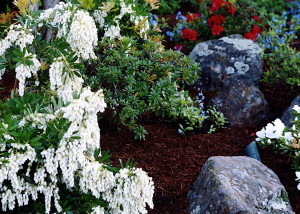Details Landscape Art is a Petaluma landscape design-build contractor. There are many areas in the North Bay where we encounter heavy clay soil conditions. Parts of Santa Rosa, and especially the East side of Petaluma were lake beds at one point in their geological history, and require special attention.

First the good news: heavy clay soils are nutrient rich. Once a plant becomes established and its roots have worked their way into the soil, it usually thrives in the adobe soil. The difficulty is in the initial planting and in the subsequent irrigation. Our recommendations are as follows:
1. Amend the soil. Add nutrients – either nitrolized sawdust or topsoil to the soil and rototill the area to break up the clay, adding air space, and allowing the new plant roots a chance to take off. The nutrients in the topsoil don’t last long – they decompose in a matter of months, but no matter. The first few months when the plant is a baby are when the roots need the air and the cultivated soil to get a good start. The nutrients help also, but once the roots get established, the natural ingredients of the native adobe clay soil provide lasting nutrition.
2. Plant high. Dig a hole twice as wide as the root ball, and a few inches shorter. Then mound dirt up to the crown of the plant so that excess water drains away. More plants die from over-watering than any other reason. If a plant is not getting enough water it will droop and ask for a drink. Then after watering it will perk up and be just fine. If a plant gets too much water there is no second chance. The roots, sitting in a pool of water, are choked off from oxygen and the plant dies from root rot.
3. Drip irrigation provides the ability to apply the correct amount of water directly to the base of the plant. The frequency of watering is critical, as the plant must be allowed to dry out in-between watering once it is established.
4. Drainage. We are a Petaluma landscape design-build contractor who recognizes that there are situations where planting high is not sufficient, and water collects in a low area – drainage may be needed if a plant will be sitting in water. There is a separate blog on drainage, but to briefly summarize, there are a few types of drainage available, depending on the situation.
- Surface drainage – creating a swale may be sufficient to direct waterway from an area to be planted.
- Catch basin and solid drainpipe – where the low spot is at the bottom of a ‘valley’, a catch basin can ‘catch’ most of the water and the solid drainpipe will direct the water away.
- French drain – where the solid drainpipe will carry water from a single location such as a catch basin or from a downspout, a French drain uses perforated pipe in a gravel filled trench, and will collect water along its entire length and carry it to a more desirable location
A Petaluma landscape design-build contractor must know how to deal with the heavy clay soils of the area.

